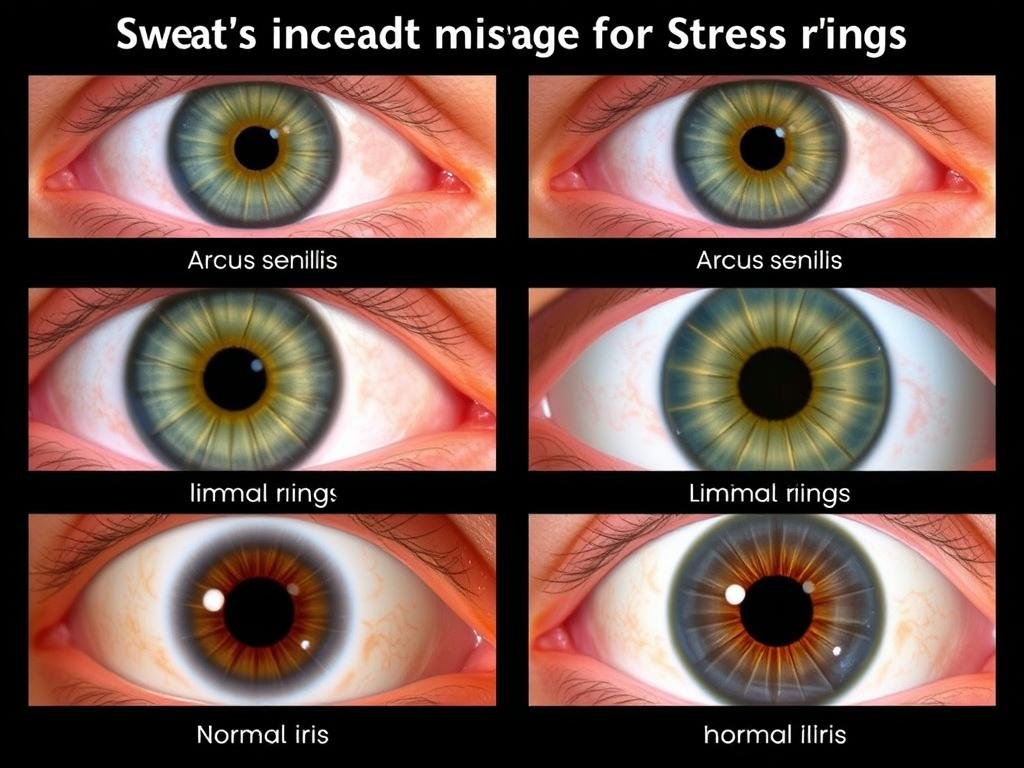Many people believe that our eyes can reveal more than just our vision health—they might also display signs of our emotional well-being. Among these potential indicators are what some call “حلقه های استرس” in the eyes. These visible patterns or circular formations in the iris have sparked curiosity about whether they truly indicate emotional stress or if they’re simply natural variations in eye structure. This article examines the scientific evidence behind استرس در چشم حلقه می کند and their purported connection to emotional stress, providing you with a clear understanding of what these ocular features might actually signify.حلقه های استرس در چشم چیست؟
Stress rings, also referred to as contraction furrows or nerve rings in iridology, appear as circular lines or indentations that form concentric patterns around the pupil in the iris. These rings can vary in number, depth, and prominence depending on the individual. They typically appear as complete or partial circles that create patterns similar to ripples in water.
In alternative health practices like iridology, these rings are believed to form due to the contraction of iris fibers in response to prolonged tension in the body. Proponents suggest that these formations reflect a state of chronic nervous tension or neurovascular dysfunction.
The physical appearance of stress rings can vary based on eye color:
- In blue or lighter-colored eyes: Appear as white or lighter-colored rings
- In brown or darker-colored eyes: May appear as darker indentations
- Can be single or multiple rings
- May form complete circles or partial arcs
According to iridology practitioners, these rings don’t typically form from short-term or acute stress but rather develop gradually in response to chronic stress over time.
The Science Behind Eye Changes During Stress
While the concept of stress rings has gained popularity in alternative health circles, it’s important to understand what science tells us about how stress affects our eyes. When we experience stress, our bodies undergo several physiological changes as part of the “fight or flight” پاسخ


How Does Stress Physically Affect the Eyes?
Scientific research has documented several ways that stress can impact eye physiology:
Pupil Dilation
During stress, the sympathetic nervous system triggers pupil dilation to allow more light into the eyes, enhancing visual perception in potentially threatening situations. This is a well-documented stress response.
Blood Flow Changes
Stress hormones like adrenaline and cortisol can cause blood vessels to constrict, potentially affecting blood flow to the eyes and surrounding tissues. This may contribute to visible changes in eye appearance.
Intraocular Pressure
Studies have shown that psychological stress can temporarily increase intraocular pressure in some individuals, which is particularly relevant for those at risk for glaucoma.
Blinking Patterns
Stress often reduces blink rate and completeness, potentially leading to dry eye symptoms and discomfort. This is why people experiencing stress may report eye strain or irritation.
However, it’s important to note that while these stress-related changes in the eyes are scientifically verified, the specific formation of permanent “حلقه های استرس” in the iris as described in iridology lacks substantial scientific validation in peer-reviewed medical literature.
Emotional Stress and Its Potential Connection to Eye Health
Chronic emotional stress has been linked to various health issues throughout the body, and the eyes are no exception. Research in psychoneuroimmunology—the study of how psychological processes influence our nervous and immune systems—suggests that prolonged stress can potentially impact eye health through several mechanisms.
What Research Shows About Chronic Stress and Eye Health
Several studies have investigated the relationship between chronic stress and eye health:
- Cortisol Effects: Prolonged elevation of cortisol (the primary stress hormone) can potentially damage blood vessels and tissues throughout the body, including those in the eyes.
- Immune System Impact: Chronic stress can suppress immune function, potentially making the eyes more vulnerable to inflammation and infection.
- Central Serous Chorioretinopathy: This condition, characterized by fluid buildup under the retina, has been associated with stress and elevated cortisol levels in multiple studies.
- Dry Eye Syndrome: Research suggests that psychological stress can exacerbate dry eye symptoms by affecting tear production and composition.
While these connections between emotional stress and eye health are supported by scientific evidence, it’s important to distinguish between these documented effects and the specific claim that stress creates visible rings in the iris. The latter remains primarily within the domain of alternative medicine rather than conventional ophthalmology.
Expert Opinions: Medical Perspectives on Stress Rings
To provide a balanced perspective on stress rings in eyes, it’s essential to consider the viewpoints of medical professionals who specialize in eye health.
“While stress certainly affects many bodily systems including aspects of eye health, there is no substantial scientific evidence supporting the idea that emotional stress creates specific ring patterns in the iris. The iris structure is largely determined by genetics and develops early in life.”
— Dr. Emily Chen, Ophthalmologist
Most ophthalmologists and optometrists point out that the iris’s structure is primarily determined by genetics and forms during fetal development. The collagen and melanin that create iris patterns are not known to reorganize significantly in response to emotional states.
Dr. Michael Roberts, a clinical psychologist specializing in stress disorders, notes: “While we can observe certain physical manifestations of chronic stress, such as tension in facial muscles or posture changes, the specific claim about stress creating iris rings lacks scientific validation in controlled studies.”
Conventional Medical View
- Iris structure is largely genetic
- No proven mechanism for stress to alter iris fibers
- Controlled studies have not validated iridology claims
- Eye changes from stress are temporary, not structural
Alternative Health Perspective
- Iris connected to nervous system
- Case observations suggest correlations
- Traditional healing systems use eye analysis
- Chronic stress may manifest physically in various ways
It’s worth noting that while conventional medicine doesn’t support the specific claims about stress rings in iridology, medical professionals do acknowledge that the eyes can reflect certain health conditions and that stress can impact eye health in other documented ways.
How to Identify: Are They Really Stress Rings?
Several eye conditions can create ring-like appearances that might be mistaken for what alternative practitioners call “stress rings.” Understanding these conditions can help you determine whether what you’re seeing might be related to stress or is simply a normal variation or different eye condition entirely.
What Do Stress Rings Look Like Compared to Other Eye Conditions?
| وضعیت | ظاهر | Cause | Medical Significance |
| Arcus Senilis | Grayish-white ring around the cornea’s edge | Lipid deposits due to aging or cholesterol | Usually benign in elderly; may indicate high cholesterol in younger people |
| Limbal Rings | Dark rings around the iris edge | Natural pigmentation | Normal variation, often more prominent in youth |
| Iris Nevi | Freckle-like spots on the iris | Melanin clusters | Usually benign but should be monitored |
| Kayser-Fleischer Rings | Golden-brown rings at cornea edge | Copper deposits from Wilson’s disease | Medical emergency requiring treatment |
| “حلقه های استرس” (in iridology) | Concentric circles within the iris | Claimed to be from chronic stress | Not recognized in conventional medicine |
When to Consult a Doctor
While many iris variations are harmless, certain changes in your eyes warrant medical attention:
Seek immediate medical care if you notice:
- Sudden appearance of rings or halos around lights
- Eye pain or discomfort with visible rings
- Changes in vision accompanying new eye markings
- Redness, inflammation, or discharge along with ring-like formations
- Any rapid or concerning change in eye appearance
For general eye health and to address concerns about potential stress effects on your eyes, regular comprehensive eye exams with an optometrist or ophthalmologist are recommended. These professionals can properly assess any unusual eye appearances and determine whether they indicate a health concern.
Effective Stress Management for Eye and Overall Health
Whether or not stress directly creates rings in your eyes, managing stress effectively is undeniably beneficial for both eye health and overall wellbeing. Research-backed approaches can help reduce the physiological impact of stress on your body, including your eyes.
Take Control of Your Stress Today
Download our comprehensive guide to evidence-based stress management techniques and start improving your eye health and overall wellbeing.
Download Free Stress Management Guide
Which Stress Management Techniques Are Most Effective?
Mind-Body Practices
- Meditation (5-20 minutes daily)
- Deep breathing exercises
- Progressive muscle relaxation
- Yoga or tai chi
- Guided imagery
Lifestyle Modifications
- Regular physical activity (150 min/week)
- Adequate sleep (7-9 hours for adults)
- Balanced nutrition
- Limiting caffeine and alcohol
- Time in nature (20+ minutes daily)
Psychological Approaches
- Cognitive-behavioral therapy
- Stress management counseling
- Social connection and support
- Journaling and expressive writing
- Setting healthy boundaries
Quick Stress Relief Technique: 4-7-8 Breathing
This simple breathing exercise can activate your parasympathetic nervous system and help reduce stress:
- Inhale quietly through your nose for 4 seconds
- Hold your breath for 7 seconds
- Exhale completely through your mouth for 8 seconds
- Repeat 3-4 times when feeling stressed
Implementing even a few of these evidence-based stress management techniques can help reduce the physical manifestations of stress throughout your body, potentially benefiting your eye health along with many other aspects of your wellbeing.
غالباً سؤالاتی در مورد حلقه های استرس در چشم پرسیده می شود
Can anxiety cause rings around the eyes?
Anxiety, as a form of stress, can cause temporary changes in the eyes such as pupil dilation and reduced blinking. However, there’s limited scientific evidence that anxiety creates permanent ring formations in the iris itself. The dark circles or puffiness that sometimes appear around the eyes during periods of anxiety are typically due to factors like disrupted sleep, dehydration, or increased blood vessel visibility—not structural changes to the iris.
Do stress rings in eyes disappear when stress is reduced?
According to iridology practitioners, stress rings may become less prominent with sustained stress reduction and nervous system support. However, complete disappearance is considered rare, especially for deeply established rings. From a conventional medical perspective, since iris structure is largely determined by genetics and early development, significant structural changes due to stress reduction would not be expected.
How are stress rings different from other iris markings?
In iridology, stress rings appear as concentric circular patterns or furrows that partially or completely surround the pupil. They differ from other iris markings such as radii solaris (spoke-like lines), crypts (small dark spots), or pigmentation changes. Stress rings specifically appear as circular depressions or lines that follow the curvature of the iris, while other markings may have different shapes, directions, or characteristics.
Can children have stress rings in their eyes?
Iridology practitioners report that stress rings can appear in children’s eyes, potentially indicating inherited stress patterns or early life stress responses. However, it’s important to note that iris patterns are largely determined by genetics, and many iris features are present from birth or early development. If concerned about a child’s stress levels, consult with pediatric healthcare providers who can assess using validated methods.
Conclusion: The Verdict on Stress Rings in Eyes
After examining the available evidence regarding stress rings in eyes and their purported connection to emotional stress, we can draw several conclusions:
What Science Supports
- Stress does cause measurable physiological changes in the eyes (pupil dilation, blood flow changes)
- Chronic stress can impact overall eye health through various mechanisms
- The eyes can reflect certain health conditions in medically recognized ways
- Stress management techniques benefit eye health regardless of iris patterns
What Lacks Scientific Validation
- The specific claim that emotional stress creates visible rings in the iris
- A physiological mechanism by which stress would alter iris fiber structure
- Controlled studies confirming iridology’s diagnostic reliability
- Recognition of “حلقه های استرس” as a diagnostic feature in conventional ophthalmology
The Verdict: While stress undoubtedly affects eye health in various ways, the specific claim that emotional stress creates visible rings in the iris lacks substantial scientific validation. What iridology identifies as “حلقه های استرس” may be normal variations in iris structure primarily determined by genetics rather than emotional states.
However, if you’re concerned about how stress might be affecting your eyes or overall health, the evidence clearly supports the value of stress management techniques and regular eye examinations with qualified healthcare professionals.










